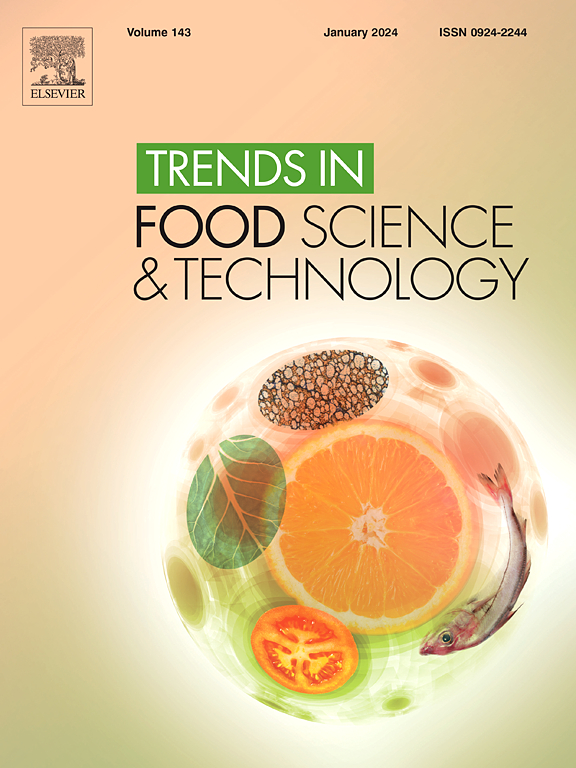单宁作为多酚和金属络合剂在预防和治疗阿尔茨海默病中的双重作用:探索饮食干预的潜力
IF 15.1
1区 农林科学
Q1 FOOD SCIENCE & TECHNOLOGY
引用次数: 0
摘要
单宁是由多个羟基组成的多酚类化合物。单宁的两个关键特性是它们与蛋白质相互作用和与金属离子络合物的能力。阿尔茨海默病(AD)是一种以记忆丧失和认知能力下降为特征的进行性神经退行性疾病。AD的主要病因包括蛋白质沉积(老年斑和神经原纤维缠结)和金属离子失衡。这与单宁的性质一致。本文综述了水解单宁和缩合单宁与蛋白质和金属的密切联系对AD的有益作用。它探讨了阿尔茨海默病的主要原因和金属离子的神经毒性作用。该综述还系统地分析了单宁如何消除导致AD的因素,并评估了摄入单宁缓解AD的饮食疗法的潜力。主要发现和结论本综述提示通过单宁缓解AD症状是一种很有前景的策略。单宁可以结合蛋白质,并通过其羟基在大脑中发挥抗氧化作用。此外,它们可以作为强大的金属络合剂,抵抗大脑中的金属离子失衡。单宁作为多酚和金属络合剂的双重作用使其具有显著的抗ad潜能。单宁通过抑制Aβ和P-tau的聚集,配合金属离子降低毒性,减轻氧化应激和神经炎症,调节脑酶活性和调节相关途径发挥其主要作用。本综述提高了对天然产物在治疗AD中的作用的理解,并支持通过单宁为基础的饮食减轻AD的策略。本文章由计算机程序翻译,如有差异,请以英文原文为准。

Dual roles of tannins as polyphenols and metal complexing agents in the prevention and treatment of Alzheimer's disease: Exploring the potential of dietary interventions
Background
Tannins are polyphenolic compounds characterized by multiple hydroxyl groups. Two key properties of tannins are their ability to interact with proteins and complex with metal ions. Alzheimer's disease (AD) is a progressive neurodegenerative disorder characterized by memory loss and cognitive decline. Key etiological factors of AD include protein deposition (senile plaques and neurofibrillary tangles) and metal ion dyshomeostasis. This aligns with the properties of tannins.
Scope and approach
This review examines the beneficial effects of hydrolysable and condensed tannins on AD based on their strong association with proteins and metals. It explores the primary causes of AD and the neurotoxic effects of metal ions. The review also systematically analyzes how tannins eliminate factors that contribute to AD and evaluates the potential of dietary therapy involving tannin intake to alleviate AD.
Key findings and conclusions
This review suggests that alleviating AD symptoms through tannins is a promising strategy. Tannins can bind proteins and exert antioxidant effects in the brain through their hydroxyl groups. Additionally, they can act as powerful metal complexing agents, resisting metal ion dyshomeostasis in the brain. Tannins' dual role as polyphenols and metal complexing agents endows them with significant anti-AD potential. Tannins exert their primary effects by inhibiting the aggregation of Aβ and P-tau, complexing metal ions to reduce toxicity, alleviating oxidative stress and neuroinflammation, modulating brain enzyme activity, and regulating related pathways. This review enhances the understanding of the role of natural products in treating AD and supports the strategy of alleviating AD through a tannin-based diet.
求助全文
通过发布文献求助,成功后即可免费获取论文全文。
去求助
来源期刊

Trends in Food Science & Technology
工程技术-食品科技
CiteScore
32.50
自引率
2.60%
发文量
322
审稿时长
37 days
期刊介绍:
Trends in Food Science & Technology is a prestigious international journal that specializes in peer-reviewed articles covering the latest advancements in technology, food science, and human nutrition. It serves as a bridge between specialized primary journals and general trade magazines, providing readable and scientifically rigorous reviews and commentaries on current research developments and their potential applications in the food industry.
Unlike traditional journals, Trends in Food Science & Technology does not publish original research papers. Instead, it focuses on critical and comprehensive reviews to offer valuable insights for professionals in the field. By bringing together cutting-edge research and industry applications, this journal plays a vital role in disseminating knowledge and facilitating advancements in the food science and technology sector.
 求助内容:
求助内容: 应助结果提醒方式:
应助结果提醒方式:


